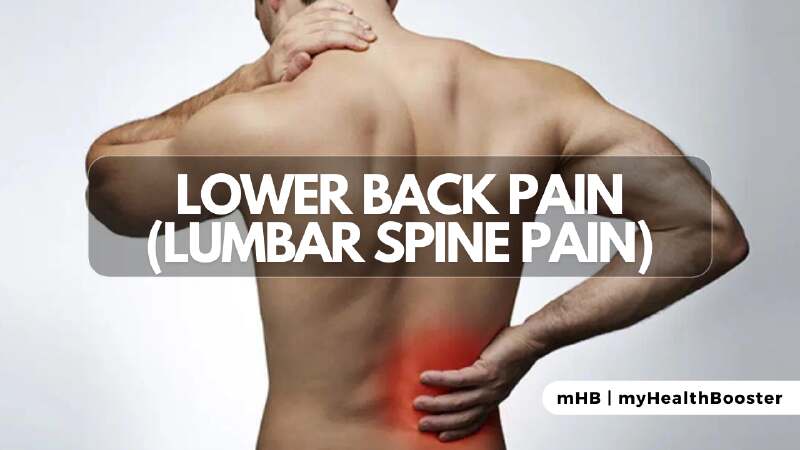Lower Back Pain
Lower back pain, also known as lumbar spine pain, demands an appreciation of the intricate anatomy in this region. Essential structures contributing to symptoms include the lumbar spine, intervertebral discs, ligaments, spinal cord, nerves, muscles, pelvic and abdominal organs, and the skin covering the lumbar area.
Anatomy of the Lumbar Spine
The lumbar spine consists of stacked vertebrae, designed to provide support while safeguarding the spinal cord. Discs between vertebrae act as cushions, and ligaments firmly connect bones. Nerves exiting through bony portals transmit sensation and stimulate muscles, while blood vessels, lymph nodes, and organs contribute to the complex network in the lower back.
Functions of the Lower Back
The lumbar area serves crucial functions, including structural support, facilitating movement, and protecting vital tissues. Whether standing, bending, or rotating at the waist, the lower back is actively involved. Additionally, it plays a pivotal role in shielding the nervous system, spinal cord, and nearby pelvic and abdominal organs.
Common Causes of Lower Back Pain
- Lumbar Strain (Acute, Chronic): Resulting from overuse, improper use, or trauma, lumbar strain involves microscopic tears in ligaments, tendons, or muscles. Treatment includes rest, medications, heat applications, and reconditioning exercises.
- Nerve Irritation and Lumbar Radiculopathy: Nerves can be irritated by mechanical pressure or disease, leading to conditions like lumbar disc disease. Lumbar radiculopathy, caused by disc damage, manifests as sciatica pain radiating down the leg and is treated based on severity.
- Bony Encroachment: Conditions causing movement or growth of vertebrae can limit space for spinal cord and nerves, leading to sciatica pain. Treatment varies from rest and exercises to surgical decompression.
- Bone and Joint Conditions: Congenital causes, degenerative changes, and injuries contribute to low back pain. Treatment ranges from conservative measures to surgery, depending on severity.
- Other Causes: Kidney problems, pregnancy, ovary issues, and tumors can also lead to low back pain. Diagnosing these conditions involves various medical examinations and imaging tests.
Uncommon Causes of Lower Back Pain
Paget’s Disease of Bone:
- Description: Abnormally weakened bone and deformity due to bone formation out of sync with normal remodeling.
- Diagnosis: Plain X-rays, bone biopsy occasionally.
- Treatment: Aspirin, anti-inflammatory medicines, pain medications, and medications that slow bone turnover.
Bleeding or Infection in the Pelvis:
- Description: Rare, often associated with blood-thinning medications or conditions like diverticulosis and pelvic inflammatory disease.
- Symptoms: Rapid-onset sciatica pain.
- Treatment: Depends on the underlying cause.
- Infection of the Cartilage and/or Bone of the Spine:
- Description: Rare conditions like septic discitis and osteomyelitis.
- Symptoms: Localized pain associated with fever.
- Treatment: Long courses of antibiotics.
Aortic Aneurysm:
- Description: Weakening of the abdominal aorta wall, leading to bulging.
- Symptoms: Pulsating low back pain.
- Treatment: Surgical repair with grafting for aneurysms of a certain size.
Shingles (Herpes Zoster):
- Description: Acute infection of nerves causing skin sensation issues.
- Symptoms: Nerve pain, skin rash on one side.
- Treatment: Symptomatic relief with lotions, antiviral medications, and pain management.
Risk Factors for Lower Back Pain
- Athletic activity, heavy lifting, trauma, kidney infection, pregnancy, osteoporosis, and aging.
Other Symptoms Associated with Lower Back Pain
- Numbness, tingling, incontinence, weakness, muscle atrophy, rash, fever, weight loss, abdominal pains, burning on urination, dizziness, joint pain, and fatigue.
Diagnosis of Lower Back Pain
- History review, physical examination, blood and urine tests, X-rays, CAT scans, MRI scans, bone scans, electromyograms (EMG), nerve conduction velocities (NCV).
Treatments for Lower Back Pain
- Individualized based on the cause. Includes self-care, medications, and sometimes surgery.
Best Exercises and Stretches for Lower Back Pain
- Kneeling lunge stretch
- Piriformis muscle stretch
- Cobra stretch
- Restful or child’s pose
- Seated spinal twist
- Legs up on the wall
- Trunk rotations
- Pelvic tilt
Worst Exercises and Stretches for Lower Back Pain
- Leg lifts/Double leg raises
- Sit-ups
- Standing toe touches
- Abdominal crunches
- Back squats
- Superman back extensions
- Exercises involving overhead or shoulder lifting of weights
- Skipping warm-ups
Complications of Lower Back Pain
- Persistent pain, radiating pain, pain after injury, pain with neurological symptoms, worsening pain with certain positions or times, pain with bowel movements or urination, pain with fever, unintentional weight loss.
Prognosis for Lower Back Pain
- Depends on the cause; acute strain injuries generally heal well, while bony abnormalities may require surgical intervention.
Prevention of Lower Back Pain
- Avoiding injury, conditioning exercise programs to strengthen the lumbar area, and seeking guidance from healthcare professionals for specific prevention programs.
Conclusion
Lower back pain is a multifaceted issue with diverse causes and manifestations. A comprehensive understanding of lumbar spine anatomy and various contributing factors is crucial for accurate diagnosis and effective treatment. From structural support to intricate neurological functions, the lower back plays a pivotal role in the body, making it imperative to address and manage pain with a tailored approach based on the underlying causes.
